How to Season a Cast Iron Skillet: Ultimate Guide for 2025
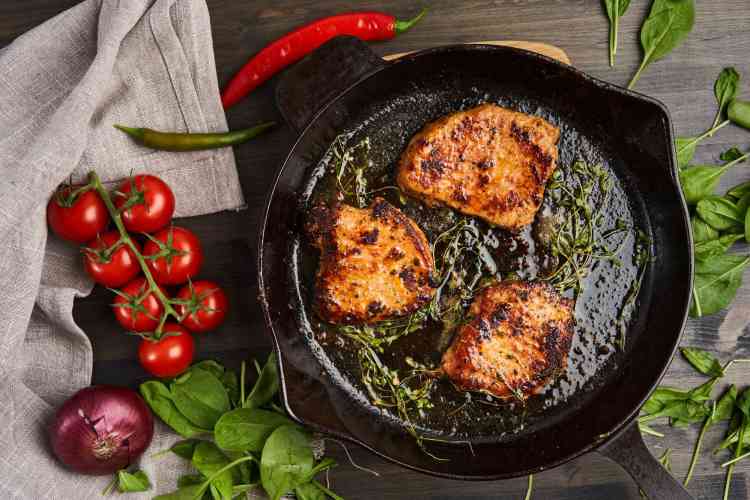
Knowing how to season a cast iron skillet is a vital part of owning this classic cookware.
There are many benefits to the use of cast iron cookware. It's durable, versatile and reliable for nearly any cooking method. It holds heat well and can be used on a variety of cooking surfaces such as gas, electric and induction. Any type of cooking utensil, including metal, can be used on cast iron skillets.
Once heated, cast iron holds in heat, which keeps food warm. Cast iron is fairly easy to clean, comes in a variety of shapes and sizes, can be used on the stove or in the oven and can be used for serving. Mini cast iron pans make a lovely presentation as serving vessels. It’s exactly what Paula Deen would use to serve Sunday dinner or gooey chocolate brownie desserts.
With proper seasoning, cast iron has a non-stick surface. Best of all, the seasoning can be reapplied over and over with the process of seasoning (unlike pans coated with Teflon or another non-stick surface). With this range of appealing traits, you'll find cast iron skillets a major feature of cooking classes in NYC all the way to cooking classes in San Francisco. We always suggest trying a cooking class near you to get used to cookware you've never used before or to address any concerns you have with specific materials.
The biggest concern many have with this metal is how to season a cast iron skillet. Proper seasoning ensures that your cast iron cookware has a long and useful life. Let’s take a look at how to season a cast iron skillet.
Jump to Section
- What is Seasoning for a Cast Iron Skillet?
- How to Season a Cast Iron Skillet
- How to Preserve Cast Iron Seasoning
What is Seasoning for a Cast Iron Skillet?
The term “seasoning” refers to the hard and naturally non-stick surface of the cast iron skillet. While most cast iron skillets come pre-seasoned these days, that smooth cast iron surface can erode over time. This means that you’ll have to season it at some time or another.
To “season” cast iron means to brush a thin layer of oil on the surface. It then gets heated until the oil “bonds” to the surface of the cast iron. This protective layer of oil prevents rust, produces heat, prevents food from sticking and provides durability and water resistance. Without seasoning, the surface of cast iron will become dry and patchy. You can avoid the problem of dryness by re-seasoning every so often.
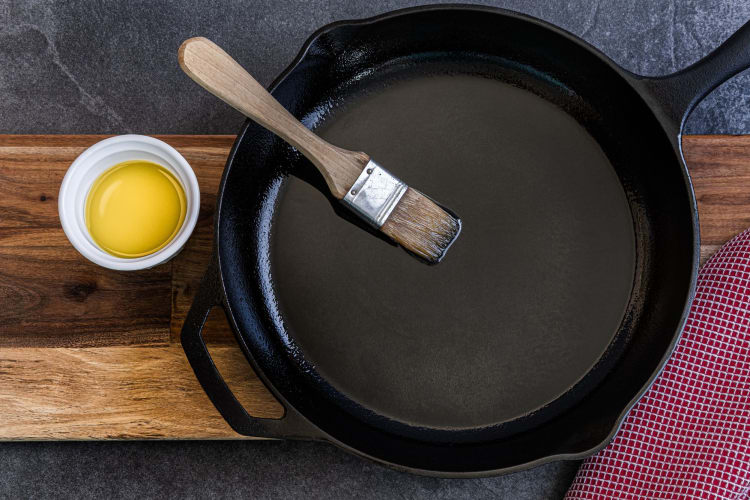
How to Season a Cast Iron Skillet
It’s time to answer that question of how to season a cast iron skillet. Even though new cast iron skillets like the KitchenAid Seasoned 12-Inch Cast Iron Skillet typically come pre-seasoned, you’ll want to do a bit more seasoning for optimum performance. If you’re working with an unseasoned or stripped cast iron skillet, you’ll want to repeat the following steps several times.
1. Wash and Dry the Pan
If your cast iron skillet is brand new or even handed down, give it a good wash with soap and water. There are differing opinions about using dish soap when learning how to clean a cast iron skillet. Some say absolutely not (your grandmother would probably agree), and others say a gentle dish soap is fine. Dish soap in the olden days of yore contained lye and vinegar, which could absolutely ruin a cast iron pan. These days, dish soap is much more gentle and not harsh enough to destroy the seasoning of a cast iron skillet.
Whatever you decide to do, you’ll want to remove any dirt and residue so that it doesn’t get baked into the layers while seasoning your cast iron skillet. This will create an uneven surface and ruin the non-stick properties. Wooden scrubbers and chainmail scrubbing pads can be used to remove baked-on food.
Once this is done, thoroughly dry the skillet.
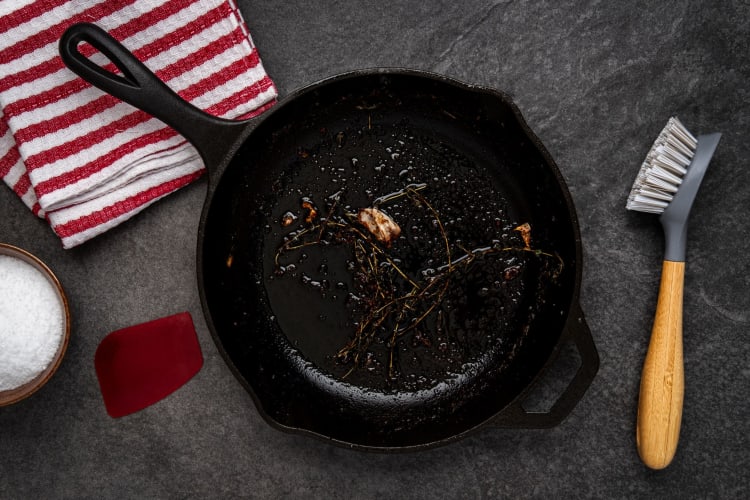
2. Brush the Pan With a Neutral Oil
The second step in how to season a cast iron skillet is to rub the pan, including the bottom and handle, with oil. The best oil to season cast iron is canola, vegetable or flaxseed. These are all neutral oils that won’t infuse heavy fragrances and flavors into the pan. You want to just coat the pan so that it feels almost dry to the touch. Don’t allow the oil to pool. If you use too much, it’ll become sticky.
The Finex Cast Iron Care Kit is an excellent product to have on hand for quick and easy seasoning when you need it. It comes with an oak wood scraper, a chain link scrubber, a bottle of organic flaxseed oil and an eyedropper.
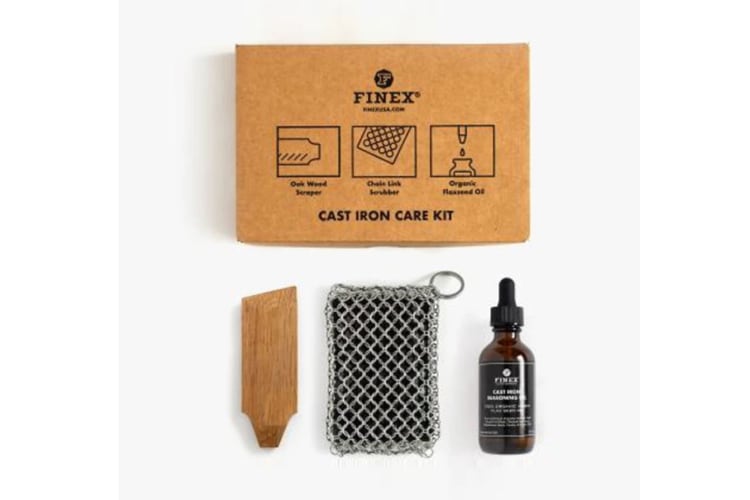
3. Bake the Pan
The next step in how to season a cast iron skillet is baking. After coating with oil, place the pan upside down in the oven at 360 degrees for one hour. Line the rack with foil or put a baking pan underneath to catch any oil drips. Using the oven rather than the stovetop provides even results without the possibility of uneven seasoning during the seasoning process.
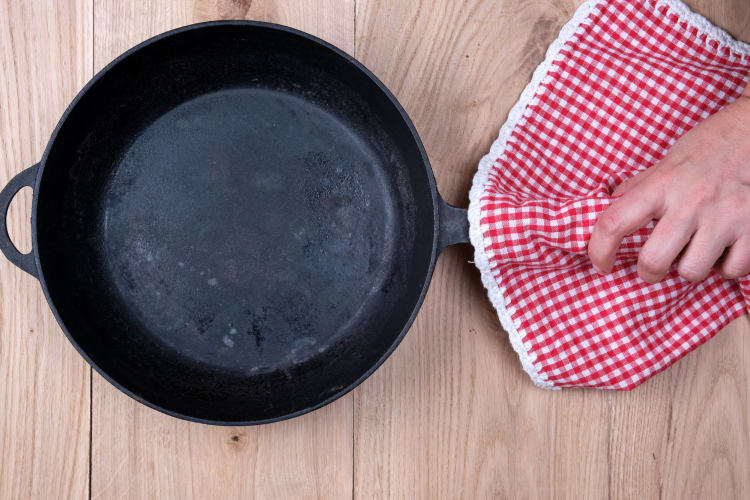
4. Allow to Cool
Turn the oven off and let the cast iron skillet cool in the oven. This is an important step in the process of seasoning a cast iron skillet.
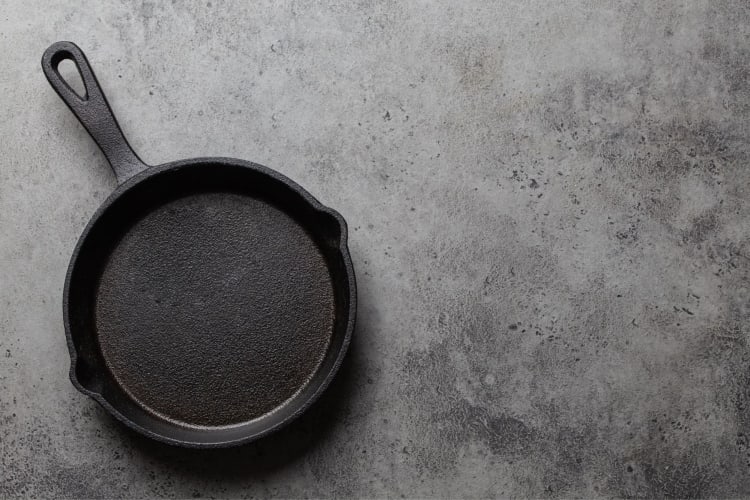
5. Repeat if Necessary
Repeat these steps several times until you’ve achieved a smooth finish. This works much better than trying to use a lot of oil, which only results in a sticky surface. These tips can also be used when comparing carbon steel vs. cast iron, as carbon steel also needs to be seasoned.
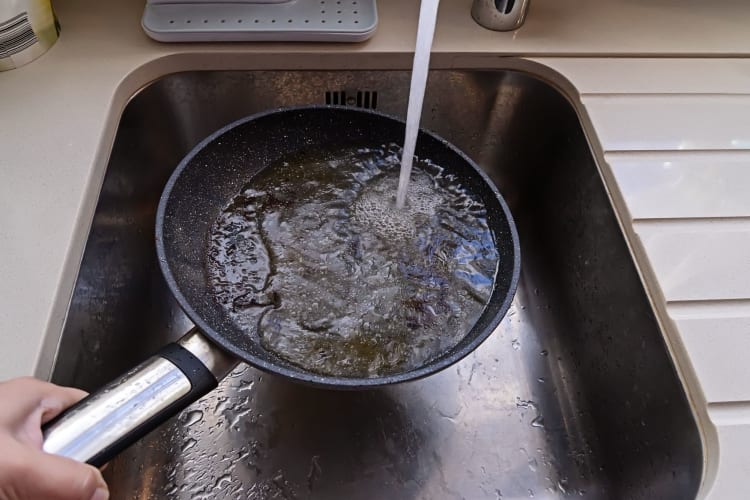
How to Preserve Cast Iron Seasoning
Now that you know the best way to season cast iron, you’ll want to protect it as much as possible. Cast iron isn’t as high-maintenance as some might think, but there are some dos and don’ts when it comes to preserving your skillet seasoning. Here are some helpful tips to remember after you’ve learned how to season a cast iron skillet.
1. Don’t Cook Acidic Foods
Acidic foods like tomatoes, citrus and vinegar can wear down the seasoning on a cast iron skillet. This can result in metallic-tasting food. When the pan is highly seasoned, it’s possible to cook these items. But it may be best to just avoid preparing acidic foods in your cast iron skillet.
2. Wash by Hand With Water
Clean your cast iron skillet with water immediately after using. Don’t allow it to soak in water as this can cause rust. The one big no-no when learning how to season a cast iron skillet is the dishwasher. Never put cast iron in the dishwasher.
3. Dry Thoroughly
Always dry a cast iron skillet thoroughly before storing it to prevent rust.
4. Scrub Stains With Kosher Salt
For baked-on stains, scrubbing with kosher salt can help. Add the salt to the water and scrub gently with a sponge.
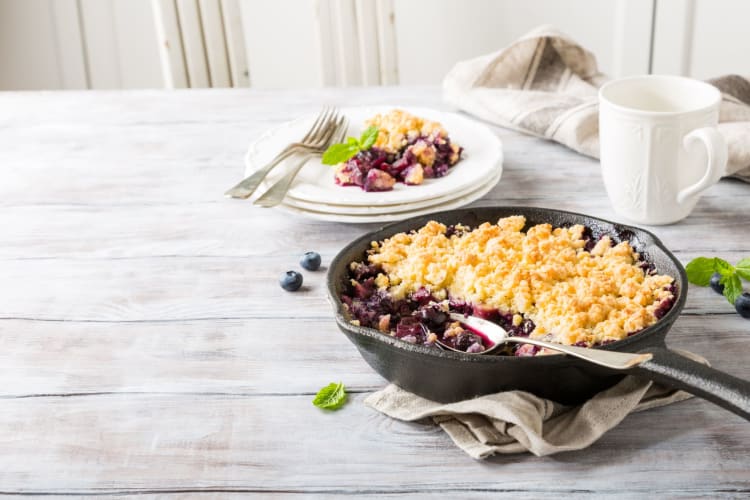
Don’t fret over the details and procedures involved in how to season a cast iron skillet. Simply use it! By using your cast iron skillet, or any other cast iron pan, you’re building up layers of seasoning and adding years of use to the best cast iron pans.
For even more ways to elevate your kitchen, check out more chef-recommended cookware in the Cozymeal Shop.

FOOD FOR THOUGHT?
Join the conversation.